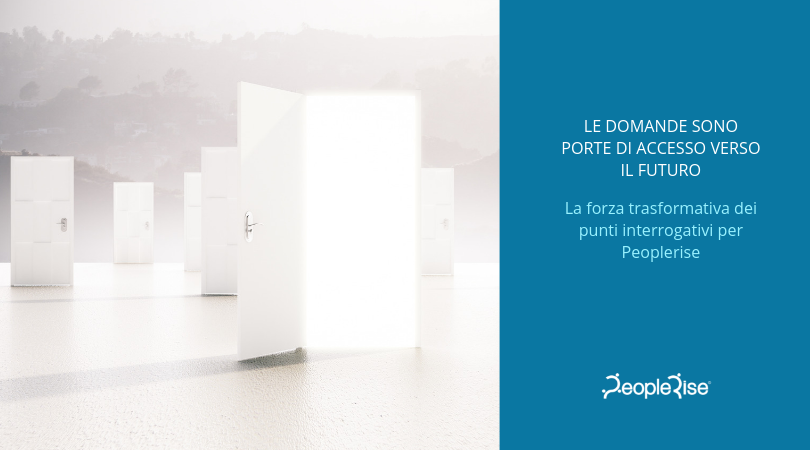For us at Peoplerise, question marks are gateways to the future. Indeed, living with a question allows us to observe reality through different eyes, to explore, to experience things that we may never have noticed otherwise, to relate to other people and open a dialogue with them. And as we travel down this path, we can try to walk to a new beat, one that is somewhat different to our usual one, so as to try and change our reality.
Almost always – because of our very nature as human beings – we find ourselves living in an imperfect world, one that is neither linear nor predetermined, and are forced to navigate imbalances and difficulties. For example, sometimes we don’t act in line with what we think, we have points of view that don’t match up with those of the people around us, and we can feel either included or excluded, depending on the context. These imbalances manifest themselves at both individual and organisational levels, for example when managers or colleagues appear to behave in a way that contrasts with the company values, or when a business strategy decided upon by the top management seems to be in contrast with the company mission. With this in mind, questions are the tools that generate tension, that allow us to constantly explore – both as individuals and as an organisation – the gap between what we observe on the outside and what we feel on the inside, between reality and the ideal, between an organisational structure made up of procedures, processes and regulations and a mission made up of values, convictions, ideals, and purpose.
At Peoplerise, we use questions in very different ways in our projects. In development paths, where we guide organisations, there are many moments at which question marks become the gateway to the future. Of the many questions we may ask, perhaps the most important is known as “the leadership question”. There are two types: individual questions (or I-Questions), i.e. those that each member of an organised community carries with them as an individual; and organisational questions (or WE-Questions), which are collective and represent the common feeling of the members who make up the single whole of the company.
For example, when I think of Peoplerise, my personal question at the moment is “How can I connect with my colleagues and still stick to my principles?”, and the one that guides us as an organisation in 2019 is “How can we feel good with each other internally in order to bring a healthy and energetic process to the work we do with our clients?”.
Generally speaking, the leadership question, be it individual or organisational, has – according to Adriaan Bekman, the author of the theory of horizontal leadership – the following characteristics:
-
it is clear and concise,
-
it regards my person/the organisation,
-
it is humble, real and not rhetorical,
-
it is concrete,
-
it is rooted in action,
-
it has the moral quality of doing the right thing for myself and others.
It is therefore based on an ecocentric vision rather than an egocentric one, and is typically formulated thusly: “How can I/we… ?”
A key first step in exploring the leadership question comes when the path is being designed together with the client. At this stage, we help the client to reflect on the situation they are currently living in and where they would like to be, and to formulate the organisation’s leadership question.
For example, one question that can be helpful in guiding our assistance is: “how can I make my organisational structure more streamlined in order to respond to clients’ requests faster and more effectively?”. This question is usually discussed with the owner, if the organisation is small, or with a Departmental Director rather than the HR Manager, if the organisation is large. It represents the beacon that will guide everything we do in the project, both in our relationship with the participants and as consultants. And it is the question that sets the tone for the entire social architecture of development.

At this point, every person involved is called upon to connect to the question of what their experience and feeling is within the organisation, and this forms the basis of a common feeling amongst all the participants of the project. For example, Peoplerise’s question, “How can we feel good and make others feel good?”, has a different meaning for each of us. And that is why we created a moment for everyone to share what it meant to them, in relation to the situation they were in, later finding a collective synthesis of the responses which was representative of everyone.
Thanks to the “work” that we can do with questions, we undertake a path of cyclical development which leads to the continuous evolution of both the individual and the organisation they are part of. By linking a concrete development action to the question, it is actually possible to start experiencing different initiatives, processes, and ways of collaborating and relating to people. If we then go on to combine these experimental actions with individual and collective moments of retrospection, to take a look at what has been learnt, what is then created within the organisation is a virtuous cycle of observation – reflection – action, which allows for us to make what we learn from experience truly count, so we can live in the present and act whilst looking to the future.
